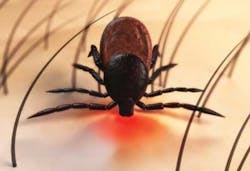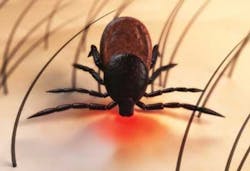Oh, deer!
Recognizing Lyme disease in our patients
by Susan Fredericks, RDH
Oh dear, the deer tick has caused an epidemic of Lyme disease (LD). There seems to be a casual attitude toward tick bites, but there is also a threat from flies, spiders, and mosquitoes. In fact, 22% of mosquitoes carry the LD bacteria. Additionally, the fox, squirrel, and rabbit can be a vector for the Ixodes scapularis tick, a member of the spider family. Those carriers don’t get LD, but our dogs and horses do. The causative infectious organism of LD is Borrelia burgdorferi (Bb), which is a spirochete similar to syphilis. One hundred strains are known in the United States, and there are more than 300 strains of these bacteria worldwide. The CDC reports cases in every state and estimates that each year there are more LD cases than AIDS and West Nile virus combined. Some doctors speculate that the number of new cases is more than 420,000. In July 2009, I became one of those statistics.
Lyme is a multisystemic disease, affecting such organs as the kidneys, spleen, heart, brain, liver, and thyroid, besides joints. It can be misdiagnosed as RA, MS, FM, CFS, ALS, Alzheimer’s, and even Parkinson’s. Antibiotic therapy can last years if one is in Stage 3. Other medications will be needed as 80% of the time the patients have coinfections ranging from babesiosis, ehrlichiosis, bartonella, and anaplasmosis to tularemia. Only 40% of those bitten will get a bull’s-eye rash, but any red patch could occur. American doctors are unprepared for this pandemic.
It is our responsibility to our patients to be assessing their health. An LD patient may have trigeminal nerve involvement that gives them neuralgia, such as tooth and jaw pain and even numbness of the tongue. If someone presents with bilateral facial paralysis, it may possibly be LD. When only one side of the face is numb, it is probably viral Bell’s palsy.
Patients report seeing doctor after doctor who are generally only familiar with the IDSA’s (Infectious Disease Society of America) guidelines. The International Lyme and Associated Diseases Society is a nonprofit medical society that developed a comprehensive way to diagnose and treat LD. See www.ILADS.org.
At this time, the Western blot and ELISA tests are only 50% accurate. PCR should also be done. New findings show that blot bands 18, 23/25, 31, 34, 37, 39, 83, and 93 are specific for LD. Band 41 shows exposure to bacteria with a flagella, which could be Bb.
Symptoms can be anything neurological from brain fog to headaches or memory deficit to demyelinization. Other familiar symptoms are weakness, light sensitivity, neck pain, muscle twitching or spasm, and swollen lymph nodes. Flu-like symptoms happen early on, then joint pain, and in the tertiary stage comes cardiac rhythm disorders. These Web sites are good resources: www.Lymesite.com or www.lymeinfo.net.
Be ready to get Herxheimer reactions if you need to have treatment. In the beginning there is an increase in cytokines and overall inflammation. Systemic enzyme supplementation is an effective way to reduce herx symptoms without short-circuiting the immune system. Supportive supplements are used by many Lyme-literate physicians.
I had the classic “bull’s eye rash,” but I kept testing negative until they did a PCR. No one ever talked about co-infections until I saw my current rheumatologist. I wound up with a pacemaker almost four years ago.
Anybody can get LD. Twenty-five percent of the cases are in children under age 14. Prevention includes wearing long-sleeved shirts and long pants in light colors so that the tick can be seen. Tuck the shirt into pants and pants into socks, and do tick checks for several days after being in infested areas. For detailed information, visit http://www.lymedisease.org.
Unfortunately, the Lymrex vaccine was taken off the market in 2002 because of adverse effects. May is Lyme Awareness Month. Please share this information with everyone you know. Just as we customize home care for our patients, physicians use varying treatments for LD. Oral doxycycline was used in my case for six months. Currently, the regime alternates between Cipro and Zithromax, along with supplements like CoQ10 and magnesium. Beating late or chronic LD requires months to years of treatment, just as in the treatment of tuberculosis.
Lyme patients are applauding the documentary “Under Our Skin.” It is bringing to light the evidence that in late Lyme, the spirochetes are sequestered inside cells, especially the nerve cells. If I had been given a month of amoxicillin when the initial rash appeared, all would be well. During my recovery, I remain positive and understand the doctor’s strategy.
Susan Fredericks, RDH, has been a hygienist since 1978 and on-the-job-trained assistant since 1974. She is on the advisory board of Berdan Institute dental assisting school, and has served on the BOT of the Northern New Jersey Dental Hygienists’ Association component. Ms. Fredericks is an Oxyfresh distributor and is on Amy’s RDH list. She participated in two oral cancer walks in New Jersey. Fredericks is employed by Dr. Peter Brusco in Kinnelon, N.J.

